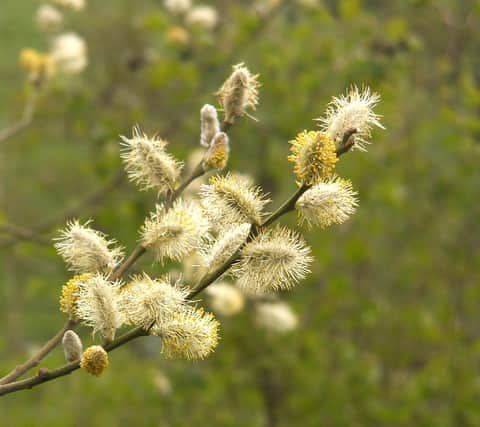Wildlife: The beautiful pussy willow is a sign that spring is on its way


Widespread in wetlands across Britain, pussy willow is deeply embedded in our culture and history. Indeed, as well as being a source of primitive aspirin it is this willow that was collected to be used as ‘palm’ on Palm Sunday. The latter is a Christian feast falling on the Sunday before Easter and commemorating Christ’s triumphal entry into Jerusalem. Palm Sunday marks the first day of Holy Week and is the last week of the Christian Lent. With their silky, silver-grey male catkins, pussy willow’s flowers emerge in January to reach their full brilliant yellow in March. It was collected and used to decorate churches and other places at Easter, and children used to take bundles to school for decoration of for the ‘nature table’. Children also wore a sprig of pussy willow if they attended Sunday School on Palm Sunday. However, because of the religious connotations, it was considered unlucky to bring sallow indoors before Palm Sunday. The male catkins of pussy willow, which is what makes the twigs so pretty to bring indoors, were also known as ‘goslings’ i.e., baby geese, and this was because they looked like fluffy young geese. Another superstition was that if willow ‘goslings’ were brought inside then your geese would not produce any babies.
In herbal medicine, willow bark was made into an infusion and used to treat rheumatism, chills, and fenland malaria or the ‘ague’. Medical practice at the time invoked the idea of ‘sympathetic magic’ so that because willows grew in wet environments, they could help treat or cure diseases and ailments associated with wet places. The treatments worked because the bark contains salicylic acid (the scientific name for willows being Salix), otherwise known as aspirin, and also present in another wetland plant, meadowsweet. When the active ingredient was isolated and synthesized in 1899, it was named ‘aspirin’ after the old name used by botanists for meadowsweet.
Advertisement
Hide AdAdvertisement
Hide AdProfessor Ian D. Rotherham, researcher, writer & broadcaster on wildlife & environmental issues, is contactable on [email protected] ; follow Ian’s blog (https://ianswalkonthewildside.wordpress.com/ ) and Twitter @IanThewildside